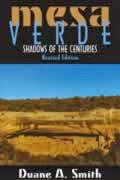The ruins at Mesa Verde were home to ancestral Puebloans (or Anasazi) from A.D. 600 to 1300; it is today a National Park, protecting the approximately 600 cliff dwellings along with thousands of artifacts and archaeological sites.
The November/December issue of Colorado Heritage, which you can check out from our library, features Mesa Verde. One article highlights the early archaeological collections at the History Colorado museum. Archaeological sites are protected today, unlike a century ago, when explorers and fortune hunters collected artifacts to sell or give to museums. The article highlights the history of the museum’s archaeological collections as well as society’s changing attitudes toward the removal of artifacts and repatriation.
A second article examines how the ancestral Puebloans lived. They had a thriving agricultural society, in which they cultivated beans, corn, and squash; they even kept domesticated turkeys. They were accomplished in pottery and weaving, and built homes that have stood for more than half a millennium. Yet they abandoned their cliff dwellings — most likely, the article explains, due to severe drought that has been documented as occurring in the late thirteenth century, about the time the ancestral Puebloans disappeared from Mesa Verde. Their descendants are today’s Pueblo people.
You can read more about Mesa Verde in two books available from our library, Mesa Verde National Park: Shadows of the Centuries and The Anasazi of Mesa Verde and the Four Corners, or check out the Park’s website.
- How to Spot the Differences Between Eagles and Hawks - August 16, 2021
- How Transportation Projects Help Tell the Story of Colorado’s Past - August 9, 2021
- Time Machine Tuesday: The Night the Castlewood Canyon Dam Gave Way - August 3, 2021


Their ancestors are today's Pueblo people? Their descendants.
Oops! Thanks for catching my typo, Jude.